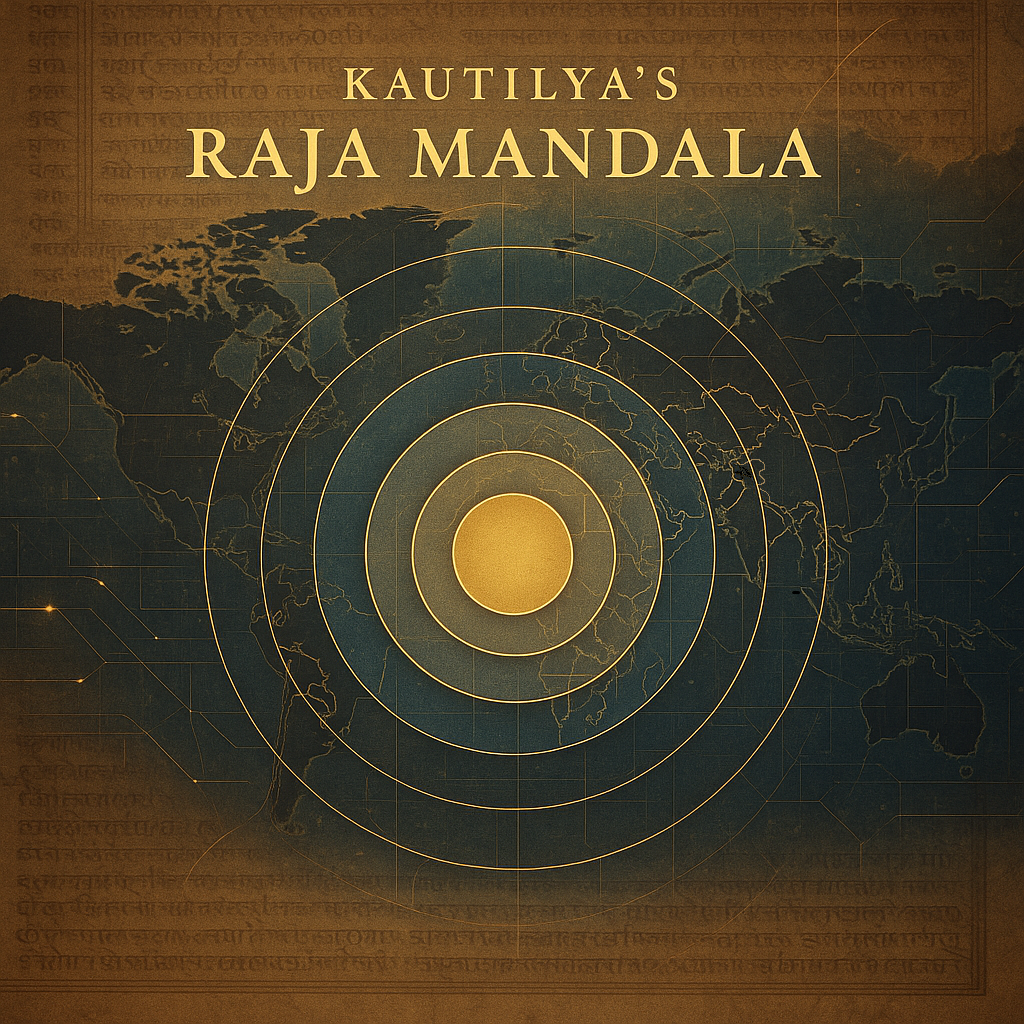|
Getting your Trinity Audio player ready...
|

- The Raja Mandala reminds us that friendship and enmity are fluid, rather than permanent, and are subject to alteration based on the national interest of the Vijigishu state.
- Kautilya’s Shadgunya (Six-Fold Policy) offers a diverse array of options for diplomatic and strategic engagement that are critical to statecraft.
- The Raja Mandala is relevant today because it serves as a powerful reminder that while technology and globalisation have shrunk the world, the timeless laws of power politics and geographical imperative remain supreme.
The modern world, characterised by the resurgence of great power rivalry, changing alliances, and untrustworthiness in strategies, has made Kautilya’s Raja Mandala a necessity and a timeless analytical lens rather than a mere historical curiosity. The liberal international order is being challenged by state-centric interests; thus, both policymakers and analysts need to understand the basic, amoral drivers of state behaviour. The time is ripe for us to reconsider the Raja Mandala since its principles of geographical realpolitik, self-interest-driven diplomacy, and the fluidity of friendship and enmity are quite evidently being staged in regional conflicts, trade wars, and military build-ups. The urgent necessity to decrypt the intricate power dynamics facilitates making the ancient text of the Arthashastra a guide of paramount importance, which leads unerringly to the realisation that:
The Raja Mandala (Circle of States) theory, a foundational concept in Kautilya’s Arthashastra, remains profoundly relevant to understanding the dynamics of contemporary international relations, particularly regional geopolitics. Rooted in realpolitik, the theory posits that a state’s strategic relationships are determined by geographical proximity and self-interest, forming a concentric circle of friends and enemies around the central power, the Vijigishu (would-be conqueror). Although conceived for a world of monarchies, its core principles of power calculation, shifting alliances, and pragmatic diplomacy translate effectively to the modern state system. The contemporary relevance of the Raja Mandala is not in its literal application but as a philosophical framework for geopolitical analysis and foreign policy formulation.
The Core Principle of Geographical Realpolitik
The fundamental principle of the Raja Mandala is the idea that “a neighbour is a natural enemy, and the neighbour’s neighbour is a possible ally.” The idea is not an absolute rule by any means, but it is a vivid presence in contemporary regional competition and alliance structures. Direct neighbours compete for resources, border security, regional hegemony, and trade routes, which situates their relationship as inherently competitive or antagonistic (Ari or Enemy). As such, states often move to create strategic relationships with that antagonistic neighbour’s neighbour (Mitra or Ally), to create some sort of strategic counter-balance or second front. This logic explains dynamic and complex interactions in regions around the world, where neighbours have, at colonies, or culturally connected neighbours – historically adversaries, built alliances with more distant countries, but continue to experience immediate geographical threats. Even though the globalisation of the world vitally affects evidence, the relative importance of geography is still the most influential independent variable in defining national security threats and regional foreign policy priorities.
The Raja Mandala (Circle of States) theory, a foundational concept in Kautilya's Arthashastra, remains profoundly relevant to understanding the dynamics of contemporary international relations, particularly regional geopolitics.
Analysis of Shifting Alliances and Self-Interest
The Raja Mandala reminds us that friendship and enmity are fluid, rather than permanent, and are subject to alteration based on the national interest of the Vijigishu state. Relationships, or Samsraya, are not based on ideology but rather on temporary utility and the calculation of power. This pragmatic, interest-based framework aligns seamlessly with the principles of modern multilateral diplomacy, for example, where alliances may often be ad hoc or issue-oriented. Major powers, for example, may simultaneously cooperate and compete with other states—a concept similar to the fluid calculus in Kautilya’s framework. States pursue “strategic autonomy,” adjusting their diplomatic and economic relations in ways to maximise security and prosperity, exactly as Kautilya prescribes. The theory advises the central state to continuously review and re-evaluate its relationships based on the changing power equations and emerging opportunities or threats, a practice that is followed by every developed state, finding itself challenged in a fluid geopolitical landscape today.
Relevance of the Six-Fold Policy (Shadgunya)
Kautilya’s Shadgunya (Six-Fold Policy) offers a diverse array of options for diplomatic and strategic engagement that are critical to statecraft. These six mechanisms — Sandhi (Peace/Treaty), Vigraha (War/Hostility), Asana (Neutrality/Waiting), Yana (Marching/Preparing for War), Samsraya (Alliance/Seeking Shelter), and Dvaidhibhava (Dual Policy of maintaining peace with one while maintaining hostility with another) — provide a broad and flexible way to conduct foreign relations.
In the contemporary context :
- Sandhi and Vigraha are simply the modern equivalents of diplomatic negotiation and open conflict.
- Asana is essentially a tactical form of neutrality or patience — waiting on the sidelines until the time to act is favourable or best optimised for your maximum benefit.
- Samsraya is observed in modern security alliances and strategic partnerships, such as collective security organisations and military blocs, where weaker states align with stronger states for protection.
- Dvaidhibhava — the dual policy — may be the most utilised tool of the six. It allows a state to maintain strong economic ties with a geopolitical rival while simultaneously deepening military cooperation with that state’s rival. This interaction demonstrates how the modern state has separated economic interest and security interest from one another in a vernacular, very practical fashion.
Application of the Mandala in South Asia’s Tripartite Rivalry
The relationship between India, Pakistan, and China provides perhaps the best example of the basic structural logic. If India is the regional Vijigishu (great power), then immediately its closest neighbour, Pakistan, acts as the archetypal Ari (Enemy) due to long-standing territorial disputes and ideological competition. This competition pushes Pakistan into collaboration with China (the Ari-Mitra, or the Enemy’s Friend). India, then, must counter this strategy by working with states in the Pacific and Indian Oceans as its own Mitras and Mitra-Mitras (e.g., Japan, Australia, France, USA) to complete the counter-balancing circle of its own. The triangular geopolitical dynamic thus is a strong corroboration of the Mandala’s principles of geography and self-interests.
The Madhyama and Dvaidhibhava in Eurasian Geopolitics
The strategic orientation of a nation such as Turkey or Iran in Eurasian geopolitics exemplifies the tactical importance of Dvaidhibhava and the Madhyama (Middle King) role. Such countries are often federally bordered by two or more great powers (e.g., Russia and the US/NATO, and/or China’s sphere) and cannot risk being in permanent hostility with any of them. Their behaviour can be described as undertaking a dual policy, for example, negotiating arms sale deals with Russia while still engaging in conversations with NATO in terms of trade and security, or actively pursuing US interests in one area while collaborating on oil prices in another. In some sense, this is the role of the Madhyama; although the Madhyama’s power is significant enough in affecting outcomes, the Madhyama’s ultimate goal is not to be sucked into a single power, but rather to exploit the rivalry of great powers to obtain advantages for themselves and ensure their autonomy.
The relationship between India, Pakistan, and China provides perhaps the best example of the basic structural logic.
Adaptation to Non-Geographical Threats and Critiques
Although the Raja Mandala’s emphasis on geography and states adjacent to one another is a constraint in a globalised world, the rationale governing it can still be applied to non-state actors and non-territorially based threats. Today, the possible “enemies” of a state might include international terrorist networks, global pandemics, economic cartels, or cyber adversaries, while the possible “allies” could be any country concerned with addressing these non-traditional security concerns. The “circle” could even be loosely applied to ideological, economic, or technological spheres, where the principles of competition and calculated cooperation continue to apply.
More critically, however, the theory is criticised for being purely state-centred and for lacking any moral dimensions in its analysis of states and state behaviour, often neglecting the role of international law, international institutions, and shared democratic values among states that may inhibit or temper states’ self-interest. Perhaps, those who criticise the amoral nature of the theory are actually reminding us of the power of the theory, as it continues to bring leaders’ and policy makers’ attention back to the reality of state-centric world politics and the inevitability of power politics for competition, even when there appears to be some form of cooperation.
A Timeless Doctrine
The Raja Mandala is relevant today because it serves as a powerful reminder that while technology and globalisation have shrunk the world, the timeless laws of power politics and geographical imperative remain supreme. It’s a straightforward, even, but powerful, analytical framework for categorising friends and foes based on realpolitik, not ideology or shared history, but on the underlying calculus of self-interest and survival. By superimposing the Mandala’s structural geometry on the diplomatic flexibility of the Shadgunya, Kautilya gave a comprehensive, actionable theory of foreign policy that still serves states’ security and influence in an anarchic international system.
References:
- Banerjee, Jyotirmoy. Strategic Studies. Mumbai: Allied Publishers, n.d.
- Mishra, Shobhit. “Kautilya’s Mandala Theory.” Research Journal of Humanities and Social Sciences 3, no. 1 (2012): 145–148. Accessed October 9, 2025. https://rjhssonline.com/HTMLPaper.aspx?Journal=Research%20Journal%20of%20Humanities%20and%20Social%20Sciences;PID=2012-3-1-32
- ”Raja Mandala Theory And Its Relevance: History Essay.” UKEssays. Last modified January 1, 2015. Accessed October 8, 2025. https://www.ukessays.com/essays/history/raja-mandala-theory-and-its-relevance-history-essay.php.
- Pant, Harsh V., and Rahul Rawat. “How China and Pakistan Work Against India.” Observer Research Foundation. June 6, 2025. https://www.orfonline.org/research/how-china-and-pakistan-work-against-india.
- Carnegie Endowment for International Peace. “Kautilya’s Arthashastra: The Strategic Cultural Roots of India’s Contemporary Statecraft.” September 21, 2023. https://carnegieendowment.org/events/2023/09/kautilyas-arthashastra-strategic-cultural-roots-of-indias-contemporary-statecraft?lang=en.
Hridbina Chatterjee is a final-year postgraduate student in International Relations at Jadavpur University, Kolkata. She has written for newspapers and think tanks, with interests in South Asian politics, India’s foreign policy, and the Indo-Pacific. Views expressed are the author’s own.
